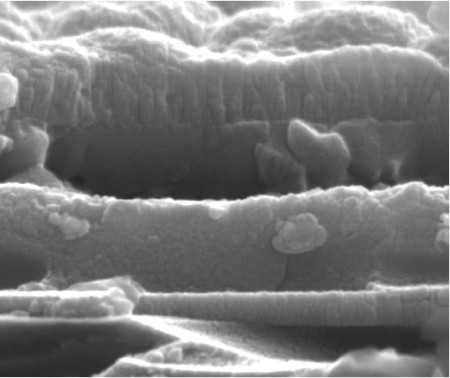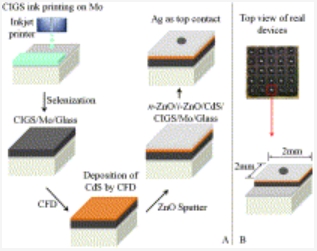Jun
30
CIGS You’re Going to Like
June 30, 2011 | 2 Comments
“CIGS” stands for the copper, indium, gallium and selenium elements comprising chalcopyrite, one of the most promising compounds for advanced solar panels. You’ll like them because engineers at Oregon State University have discovered the initial way to create successful “CIGS” solar devices with inkjet printing.
The familiar inkjet printer is a low-cost technology that with the personal computer has revolutionized home and small office printing. The Oregon State (OSU) research and development may soon offer similar benefits for the future of solar energy.
Along with a fast and low cost way to apply chalcopyrite the OSU process reduces raw material waste by 90 percent and will significantly lower the cost of producing solar energy cells. This is a critical point.
Chih-hung Chang, an OSU professor in the School of Chemical, Biological and Environmental Engineering set up the explanation by saying, “This is very promising and could be an important new technology to add to the solar energy field. Until now no one had been able to create working CIGS solar devices with inkjet technology.” Part of the advantage of this approach is a dramatic reduction in wasted material. Instead of depositing chemical compounds on a substrate with a more expensive vapor phase deposition – wasting most of the material in the process – inkjet technology could be used to create precise patterning with very low waste.
Chang’s main point, “Some of the materials we want to work with for the most advanced solar cells, such as indium, are relatively expensive. If that’s what you’re using you can’t really afford to waste it, and the inkjet approach almost eliminates the waste.”
CIGS laid out with ink jet technology is a huge improvement on a cost efficiency basis. A layer of chalcopyrite one or two microns thick has the ability to capture the energy from photons about as efficiently as a 50-micron-thick layer made with silicon. That’s a 96 to 98% reduction in material.
The OSU team’s results have been published in the journal Solar Energy Materials and Solar Cells, and a patent application has been filed on the discovery. The researchers say via the OSU press release further research is needed to increase the efficiency of the cell. With good efficiency progress the work could lead to a whole new generation of solar energy technology
The paper discusses how the team was able to create an ink that could print chalcopyrite onto substrates with an inkjet approach, with a solar power conversion efficiency of about 5 percent. The OSU researchers say that with continued research they should be able to achieve an efficiency of about 12%, which would make a commercially viable solar cell.
When solar panel are driven to a low enough cost the efficiency can be lower. Yet CIGS and ink jet application is only at the first stage. In related work of collaboration with Greg Herman, an OSU associate professor of chemical engineering, the OSU team is studying other compounds that might also be used with inkjet technology, and cost even less.
Most processes for producing solar cells are time consuming, or require expensive vacuum systems or toxic chemicals. The OSU team is working to eliminate some of those roadblocks and create much less costly solar technology that is also more environmentally friendly. New jobs and industries in the Pacific Northwest could evolve from such initiatives, they say.
It’s about cost and the upfront investment. The OSU team’s believes if costs can be reduced enough and other hurdles breached, it might even be possible to create solar cells that could be built directly into roofing materials, the scientists say, opening a huge new potential for solar energy.
The team’s paper concludes in part with, “In summary, a simple, fast, and direct-write, solution-based deposition process is developed for the fabrication of high quality CIGS solar cells,” the researchers wrote in their conclusion. “Safe, cheap, and air-stable inks can be prepared easily by controlling the composition of low-cost metal salt precursors at a molecular level.”
This looks very good. 5% to start, 12% in striking distance, and this is just the opening break out. This idea is a good one. Drive the cost low enough and 12% looks great.
Be sure to check the “Related Article” in the right column of the paper’s abstract page. You’ll note the Swiss announced in 2004 a coating at 13.6% on the way to 15%. Go guys, go!
Comments
2 Comments so far




CIGS as a concept I like. Saw the paper yesterday and it has promise. But you won’t see CIGS deployed as a inkjet technology. Go look at the page to print speed at high quality for inkjet, factor in the square inches of a standard PV panel and do the math. Anywhere from 3-5min per panel. Even at multiples of a 1000 printers the financial math won’t make it.
CIGS will be accomplished by some other direct deposit method where the run rates will be several thousand square feet a day.
Nanosolar is way ahead of these guys:
“Nanosolar is a company that prints the semiconductive compound of copper, indium, gallium, and selenium (CIGS) onto thin foil. The company uses a web press application and “can produce a hundred feet of continuously rolled solar cell per minute” (Inslee & Hendricks, 2008, p. 72). Their nanoparticle ink mixture, consisting of CIGS and the necessary components for proper dispersion, is coated onto “a specially-prepared proprietary alloy of metal foil using high-throughput coating/printing techniques” (Nanosolar, 2010, paragraph 4). This method of printing has replaced the conventional process of high-vacuum deposition, which is much more time consuming. Nanosolar has taken the economics and processes of printing and applied them to the formation of solar cells and seems to have done so very successfully. Their process should make this type of solar cell electricity as cheap as the current electricity taken off the grid (Inslee & Hendricks, 2008). The National Renewable Energies Laboratory certifies that their solar cells have up to a 15.3% efficiency (Nanosolar Communications, 2009), which is comparable to conventional crystalline silicon cells. The product itself is also thin and flexible, which could be useful in a number of applications. Nanosolar’s thin film cells are much more economical than traditional silicon cells, and they can be mass-produced very quickly thanks to the use of a printing process.”